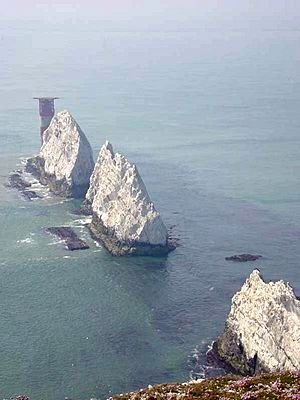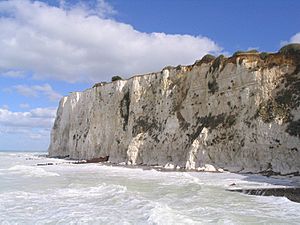Upper Cretaceous facts for kids

The Upper Cretaceous was the last major time period of the Cretaceous Era. It started about 100.5 million years ago and ended 66 million years ago.
Scientists divide the Cretaceous into two main parts: the Lower (early) and Upper (late) Cretaceous. This is because the rocks formed during these times are different. These rocks tell us a lot about what the Earth was like back then. The Upper Cretaceous is further split into six smaller time periods: Cenomanian, Turonian, Coniacian, Santonian, Campanian, and Maastrichtian.
Contents
What is Chalk?
The Upper Cretaceous is famous for being the time when a lot of chalk formed. Chalk is a type of soft, white rock. It is made up of tiny, tiny pieces of calcium carbonate (CaCO3). These tiny pieces are called coccoliths.
Coccoliths are so small that you can barely see them with a regular microscope. To see their details, you need a special electron microscope. These tiny plates come from single-celled planktonic algae called coccolithophores. They lived in the oceans and, when they died, their tiny plates sank to the seafloor. Over millions of years, these layers of plates turned into the chalk we see today.
The only other rock often found in chalk is flint. Flint is a very hard rock made of silica (SiO2). It comes from the skeletons of other algae and animals that had silica in their bodies. When you find flint in chalk, it often means that the climate was a bit different during that time.
Life in the Upper Cretaceous
The Cretaceous was the last time that dinosaurs ruled the land. Awesome dinosaurs like Triceratops, Tyrannosaurus, and Velociraptor lived during the Upper Cretaceous. In the oceans, the giant Mosasaurus was the top predator.
During this period, birds became much more varied and common. Also, flowering plants developed a lot. They became the main type of plant on land, just like they are today. The Upper Cretaceous period ended with a huge event called the K/T extinction event.
Major Extinction Events
The end of the Cretaceous period is known for a massive extinction event. This event caused the dinosaurs to disappear. However, many groups of animals had already died out even before this big event.
There was an earlier extinction event during the Upper Cretaceous. It happened around 95 to 90 million years ago, at a time known as the Cenomanian–Turonian boundary. Scientists believe there was a lot of volcanic activity during this time. This activity caused big changes in the ocean, which affected sea life.
This earlier event led to the extinction of pliosaurs, most ichthyosaurs, and many types of pterosaurs. The exact cause is still being studied. However, it led to the oceans losing a lot of oxygen for nearly half a million years. This lack of oxygen caused about 27 percent of marine animals without backbones to die out. This included certain types of plankton, mollusks, bivalves, and tiny fossils.
This global change also made the Earth's atmosphere and oceans much warmer. Rocks from this time show changes in certain elements. They also show changes in something called δ13C, which tells us about how much life was in the seas. This means the oceans were not as good for life, and many species could not survive.
Images for kids
See also
 In Spanish: Cretácico superior para niños
In Spanish: Cretácico superior para niños




